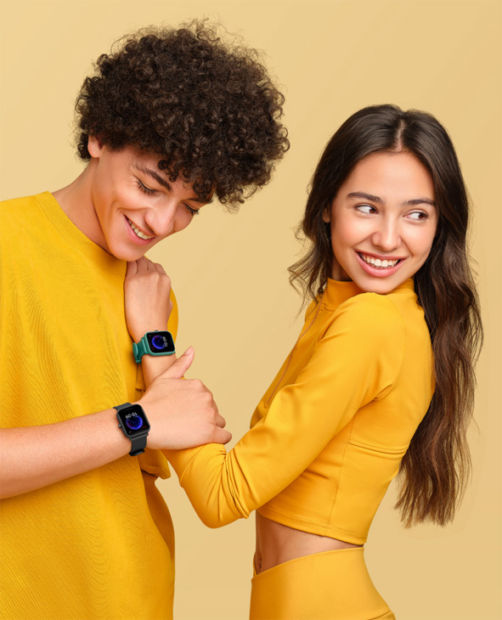Zepp launches wearable chip and smartwatch OS
- July 26, 2021
- Steve Rogerson

Chinese firm Zepp Health, formerly Huami, introduced a smart wearable chip, smartwatch operating system and blood pressure measurement technology at its annual developers conference this month.
The Huangshan 2s smart wearable chip offers performance increases from the Huangshan 2, which was introduced at the same conference last year. Compared with its predecessor, it reduces operating power consumption by 56% and dormant power consumption by 93% and improves graphics performance by 67%.
Huangshan 2s is said to be the first wearable AI processor that employs a dual-core Risc-V instruction set architecture. It was taped out in March and the firm hopes it will become one of the key smart wearable chips for the company’s third generation of Amazfit smart watches.
The aim of the Zepp OS is to create an energy efficient open architecture for app developers and a platform for health management.
Zepp OS is not only a smartwatch operating system but also the core of an open health management platform. To avoid the limitations and problems of some other mobile operating systems, Zepp developed a different and lightweight mini programme plus cloud concept. The operating system is also designed with an emphasis on health, user experience and privacy protection.
At 55Mbyte, the Zepp OS is one-tenth the size of the company’s previous Amazfit OS and it is one twenty-eighth the size of Apple Watch OS 8. Operating power consumption of is 65% lower than Amazfit OS while one comparison test generated a 190% increase in endurance in one of the company’s smartwatches.
The company is opening the mini programme framework for developers to create apps that leverage the data and intelligence from the company’s proprietary biosensor array and AI chip.
The operating system provides a reliable and stable Bluetooth channel to connect with smart phones, smart homes, other health devices and payment systems. It supports 4G and 5G modules and integrates TCP/IP network protocols to allow the smartwatch to be connected directly to the cloud without a smart phone. And it supports internet cloud service applications for music, voice commands and fitness, such as NetEase Music, Spotify, Alexa, Joyrun and Strava.
The Zepp OS will be officially launched towards the end of the year and will become an open health management platform that will allow thousands of developers to participate and create a global open health ecosystem for smart wearable users.
Zepp Health licensed Zepp OS and Huangshan 2s smart wearable chip technologies to Yitong Technology to enrich the IoT ecosystem in China, by connecting with smart cars and other smart home appliances.
“We envision the Zepp OS to be an OS comprised of thousands of developers with tens of thousands of mini smart watch applications that form an ecosystem to help our users better manage their health and enjoy better lives,” said chief executive officer Wang Huang. “The difficulty of developing such a comprehensive smart watch OS focused on health management from the ground up is definitely as difficult as developing a new chip.”
Zepp Health also introduced PumpBeats, a non-invasive and sleeveless blood pressure measurement system on Amazfit smartwatches. Based on five years of technical research and employing the company’s proprietary Huangshan AI chip and biosensor array, the algorithm can measure blood pressure through the watch’s optical sensors. Clinical testing of hypertensive patients at the First Hospital of Peking University found deviations in PumpBeats measurements of less than 5.14mmHg in systolic and less than 4.88mmHg in diastolic pressure.
Blood pressure measurement takes 30 seconds and PumpBeats is expected to be available in Amazfit products by the end of the yeaer. Additionally, continuous blood pressure monitoring is under development.
Last year, Zepp Health recognised that its miniaturisation, AI, chip, sensor and algorithm engineering expertise could be leveraged for medical imaging technologies. The company created partnerships and made financial investments in several medical imaging companies, including Promaxo and Hyperfine. These miniaturised and portable MRI, x-ray and ultrasound systems are targeting the location, application and costs of medical imaging, which could impact improved care and lower costs globally.
At the conference, Zepp Health announced an additional engineering development effort by the company in China to supplement those efforts. Research will go into needs of the China market, as well as beginning to explore how the company’s engineering and IP can complement and add value to these budding new technologies. It is anticipated that the medical imaging data generated from low-cost advanced portable diagnostic imaging, combined with continuous health data from smart wearables, will advance the ability to detect potential health problems at earlier stages.
Since its inception in 2013, the company has developed a platform of proprietary technology including AI chips, biometric sensors and data algorithms, which drive smart health devices for consumers, data analytics services for population health, and industrial medical technology for diagnostics and care delivery. It is one of the largest developers of smart wearable health and consumer fitness devices, shipping 46 million units in 2020, including 33 million smart watches.
Zepp Health changed its name from Huami in February to emphasise its health focus with a name that resonates across languages and cultures globally. The company is based in Hefei, China, with US operations in Cupertino, California.





